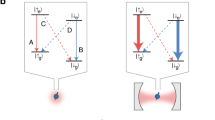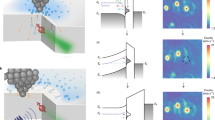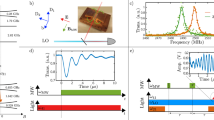Abstract
Nuclear spins of noble gases can maintain coherence for hours at ambient conditions because they are isolated by complete electron shells1. This isolation, however, impedes the ability to manipulate and control them by optical means or by coupling to other spin gases2,3,4. Here we achieve strong coherent coupling between noble-gas spins and the optically accessible spins of an alkali-metal vapour. The coupling emerges from the coherent accumulation of stochastic spin-exchange collisions. We obtain a coupling strength ten times higher than the decay rate, observe the coherent and periodic exchange of spin excitations between the two gases and demonstrate active control over the coupling by an external magnetic field. This approach could be developed into a fast and efficient interface for noble-gas spins, enabling applications in quantum sensing and information5,6.
This is a preview of subscription content, access via your institution
Access options
Access Nature and 54 other Nature Portfolio journals
Get Nature+, our best-value online-access subscription
$29.99 / 30 days
cancel any time
Subscribe to this journal
Receive 12 print issues and online access
$209.00 per year
only $17.42 per issue
Buy this article
- Purchase on Springer Link
- Instant access to full article PDF
Prices may be subject to local taxes which are calculated during checkout




Similar content being viewed by others
Data availability
All data needed to evaluate the conclusions in the paper are present in the paper. The data that support the findings of this study and additional data are available from the corresponding author upon request.
References
Gentile, T. R., Nacher, P. J., Saam, B. & Walker, T. G. Optically polarized 3He. Rev. Mod. Phys. 89, 045004 (2017).
Walker, T. G. & Larsen, M. S. Spin-exchange-pumped NMR gyros. Adv. Atom. Mol. Opt. Phys. 65, 373 (2016).
Kornack, T. W. & Romalis, M. V. Dynamics of two overlapping spin ensembles interacting by spin exchange. Phys. Rev. Lett. 89, 253002 (2002).
Jimenez-Martinez, R. et al. Optical hyperpolarization and NMR detection of 129Xe on a microfluidic chip. Nat. Commun. 5, 3908 (2014).
Katz.O., Shaham, R., Polzik, E. S. & Firstenberg, O. Long-lived entanglement generation of nuclear spins using coherent light. Phys. Rev. Lett. 124, 043602 (2020).
Katz, O., Reches, E., Shaham, R., Gorshkov, A. V. & Firstenberg, O. Optical quantum memory with optically inaccessible noble-gas spins. Preprint at https://arxiv.org/abs/2007.08770 (2020).
Heil, W. et al. Spin clocks: probing fundamental symmetries in nature. Ann. Phys. 525, 539–549 (2013).
Gemmel, C. et al. Ultra-sensitive magnetometry based on free precession of nuclear spins. Eur. Phys. J. D 57, 303–320 (2010).
Kornack, T. W., Ghosh, R. K. & Romalis, M. V. Nuclear spin gyroscope based on an atomic comagnetometer. Phys. Rev. Lett. 95, 230801 (2005).
Thrasher, D. A. et al. Continuous comagnetometry using transversely polarized Xe isotopes. Phys. Rev. A 100, 061403 (2019).
Kitching, J. Chip-scale atomic devices. Appl. Phys. Rev. 5, 031302 (2018).
Chupp, T. & Swanson, S. Medical imaging with laser-polarized noble gases. Adv. Atom. Mol. Opt. Phys. 45, 41–98 (2001).
Brown, J. M., Smullin, S. J., Kornack, T. W. & Romalis, M. V. New limit on Lorentz- and CPT-violating neutron spin interactions. Phys. Rev. Lett. 105, 151604 (2010).
Jackson Kimball, D. F., Boyd, A. & Budker, D. Constraints on anomalous spin–spin interactions from spin-exchange collisions. Phys. Rev. A 82, 062714 (2010).
Alonso, R., Blas, D. & Wolf, P. Exploring the ultra-light to sub-MeV dark matter window with atomic clocks and co-magnetometers. J. High Energy Phys. 2019, 69 (2019).
Bloch, I. M., Hochberg, Y., Kuflik, E. & Volansky, T. Axion-like relics: new constraints from old comagnetometer data. J. High Energy Phys. 2020, 167 (2020).
Chupp, T. E., Fierlinger, P., Ramsey-Musolf, M. J. & Singh, J. T. Electric dipole moments of atoms, molecules, nuclei, and particles. Rev. Mod. Phys. 91, 015001 (2019).
Katz, O., Shaham, R., Reches, E., Gorshkov, A. V. & Firstenberg, O. Optimal control of an optical quantum memory based on noble-gas spins. Preprint at https://arxiv.org/abs/2007.10177 (2020).
Dantan, A. et al. Long-lived quantum memory with nuclear atomic spins. Phys. Rev. Lett. 95, 123002 (2005).
Serafin, A., Fadel, M., Treutlein, P. & Sinatra, A. Nuclear spin squeezing in helium-3 by continuous quantum nondemolition measurement. Phys. Rev. Lett. 127, 013601 (2021).
Serafin, A., Castin, Y., Fadel, M., Treutlein, P. & Sinatra, A. Étude théorique de la compression de spin nucléaire par mesure quantique non destructive en continu. C. R. Phys. 22, 1–35 (2021).
Katz, O., Shaham, R. & Firstenberg, O. Quantum interface for noble-gas spins. PRX Quantum 3, 010305 (2022).
Hammerer, K., Sorensen, A. S. & Polzik, E. S. Quantum interface between light and atomic ensembles. Rev. Mod. Phys. 82, 1041–1093 (2010).
Shaham, R., Katz, O. & Firstenberg, O. Quantum dynamics of collective spin states in a thermal gas. Phys. Rev. A 102, 012822 (2020).
Sun, J. et al. Spatial multiplexing of squeezed light by coherence diffusion. Phys. Rev. Lett. 123, 203604 (2019).
Dellis, A. T., Loulakis, M. & Kominis, I. K. Spin-noise correlations and spin-noise exchange driven by low-field spin-exchange collisions. Phys. Rev. A 90, 032705 (2014).
Kong, J. Measurement-induced, spatially-extended entanglement in a hot, strongly-interacting atomic system. Nat. Commun. 11, 2415 (2020).
Mouloudakis, K. & Kominis, I. K. Spin-exchange collisions in hot vapors creating and sustaining bipartite entanglement. Phys. Rev. A 103, L010401 (2021).
Sherson, J. F. et al. Quantum teleportation between light and matter. Nature 443, 557–560 (2006).
Gorshkov, A. V., Andre, A., Fleischhauer, M., Sorensen, A. S. & Lukin, M. D. Universal approach to optimal photon storage in atomic media. Phys. Rev. Lett. 98, 123601 (2007).
Firstenberg, O. et al. Self-similar modes of coherent diffusion. Phys. Rev. Lett. 105, 183602 (2010).
Appelt, S. et al. Theory of spin-exchange optical pumping of 3He and 129Xe. Phys. Rev. A 58, 1412–1439 (1998).
Batz, M., Nacher, P. J. & Tastevin, G. Fundamentals of metastability exchange optical pumping in helium. J. Phys. Conf. Ser. 294, 012002 (2011).
Walter, D. K., Happer, W. & Walker, T. G. Estimates of the relative magnitudes of the isotropic and anisotropic magnetic-dipole hyperfine interactions in alkali-metal-noble-gas systems. Phys. Rev. A 58, 3642–3653 (1998).
Katz, O., Shaham, R. & Firstenberg, O. Coupling light to a nuclear spin gas with a two-photon linewidth of five millihertz. Sci. Adv. 7, eabe9164 (2021).
Chen, W. C., Gentile, T. R., Ye, Q., Walker, T. G. & Babcock, E. On the limits of spin-exchange optical pumping of 3He. J. Appl. Phys. 116, 014903 (2014).
Allred, J. C., Lyman, R. N., Kornack, T. W. & Romalis, M. V. High-sensitivity atomic magnetometer unaffected by spin-exchange relaxation. Phys. Rev. Lett. 89, 130801 (2002).
Walker, T. G. & Happer, W. Spin-exchange optical pumping of noble-gas nuclei. Reviews of Modern Physics 69, 629–642 (1997).
Vasilakis, G., Shah, V. & Romalis, M. V. Stroboscopic Backaction Evasion in a Dense Alkali-Metal Vapor. Physical Review Letters 106, 143601 (2011).
W. Happer, Y.-Y. Jau, and T.Walker, Optically Pumped Atoms ISBN 978-3-527-40707-1 (WILEY-VCH, 2010)
Happer, W. & Tam, A. C. Effect of rapid spin exchange on the magnetic-resonance spectrum of alkali vapors. Physical Review A 16, 1877–1891 (1977).
Romalis, M. V., Sheng, D., Saam, B. & Walker, T. G. Comment on “New Limit on Lorentz-Invariance- and C P T -Violating Neutron Spin Interactions Using a Free-Spin-Precession 3He -129Xe Comagnetometer”. Physical Review Letters 113, 188901 (2014).
Katz, O., Peleg, O. & Firstenberg, O. Coherent Coupling of Alkali Atoms by Random Collisions. Physical Review Letters 115, 113003 (2015).
Duan, L.-M., Cirac, J. I., Zoller, P. & Polzik, E. S. Quantum Communication between Atomic Ensembles Using Coherent Light. Physical Review Letters 85, 5643–5646 (2000).
Acknowledgements
We thank C. Avinadav and R. Finkelstein for fruitful discussions. We acknowledge financial support by the Israel Science Foundation, the European Research Council starting investigator grant Q-PHOTONICS 678674, the Minerva Foundation with funding from the Federal German Ministry for Education and Research and the Laboratory in Memory of Leon and Blacky Broder.
Author information
Authors and Affiliations
Contributions
R.S., O.K. and O.F. all contributed to the experimental design, construction, data collection and analysis of this experiment. R.S. claims responsibility for all figures. The authors wrote the manuscript together.
Corresponding author
Ethics declarations
Competing interests
The authors declare no competing interests.
Peer review
Peer review information
Nature Physics thanks the anonymous reviewers for their contribution to the peer review of this work.
Additional information
Publisher’s note Springer Nature remains neutral with regard to jurisdictional claims in published maps and institutional affiliations.
Extended data
Extended Data Fig. 1 Spin-exchange optical pumping.
Typical measurement of the pumping process of helium-3 by optically pumped potassium vapor. Here the potassium density is na = 4.9 ⋅ 1014 cm−3, and the helium depolarization time is \({T}_{1,{{{\rm{act}}}}}^{{{{\rm{b}}}}}=3.9\) h.
Extended Data Fig. 2 Variables extracted from fitting Eq. (3) to the measured signals for each exchange time t, as exemplified in Extended Data Fig. 3.
a. The change in alkali precession frequency ωa(t, τ = 0) [see Eq. (2)] manifests the change in the slowing-down factor due to alkali depolarization. b. The degree of alkali polarization pa(t) (in semi-log scale). In a and b, dashed black line correspond to the fitted multi-exponential model, and dotted lines present its confidence bounds. These are used as uncertainty estimations when using pa(t) to scale \(\langle \hat{a}\rangle\) and \(\langle \hat{b}\rangle\). Less reliable data, extracted when the excitations reside predominantly in the noblegas spins, are marked in gray. c. The two frequency components (amplitude squared) of the normalized Faraday rotation signal \({\overline{S}}_{x}(t+\tau )\). Note the factor of (Δ/J)2 ≳ 100 between them. Each data-point is averaged over 12 to 20 repetitions of the sequence.
Extended Data Fig. 3 Pulse sequence and typical results of an excitation-exchange measurement.
a. First, we turn off the pumping and bring the two species to strong coupling with a small detuning Δ. We then generate a transverse excitation with a transverse magnetic field pulse. At a later time t, we halt the exchange by increasing the axial magnetic field and setting a large Δ. b. Example of a measured signal with exchange duration t = 11 ms, with Δ = − 1.15J before t, and Δ = 790 Hz ≫ J after t. We measure the alkali electron spin (red) which, once Δ is increased, can be used as a magnetometer that senses the noble-gas spin. The fast oscillations of the signal correspond to the Larmor precession of the alkali spin, and the slow modulation corresponds to the noble-gas precession. The latter is highlighted by the blue line (generated by low-pass filtering of the signal for illustrative purposes). We fit the signal to the model from Eq. (3) (dashed black line) and find the amplitudes of the alkali and noble-gas components at time t, which are used to estimate \(\langle \hat{a}(t)\rangle\) and \(\langle \hat{b}(t)\rangle\), respectively. The same fit also provides pa(t).
Supplementary information
Supplementary Information
Supplementary Sections 1 and 2, and reference.
Source data
Source Data Fig. 1
Contains the data presented in Fig. 1b (measurement of noble-gas coherence time).
Source Data Fig. 2
Contains the data presented in Fig. 2. Sheet labelled ‘exp’ contains the measured data points and error bars; coloured error bars, denoting measurements uncertainty and scattering, are presented in ‘dNa’\‘dNb’ columns, while grey error bars, denoting uncertainty in the data interpretation\scaling, are presented in ‘eNa+\-’,‘eNb+\-’ columns. Sheet labelled ‘model’ contains the data of the model presented on top of measurements (Fig. 2, solid lines).
Source Data Fig. 4
Contains the data presented in Fig. 4. All spectrum data (sheets ‘spectrum_exp’, ‘spectrum_model’ and ‘spectrum_imperfect_model’) appear such that the first row contains the ‘Delta/J’ values, the first column contains the ‘omega/J’ values and the rest of the table contains the normalized Fourier amplitudes presented in the figure. Sheet ‘spectrum_exp’ contains the data of Fig. 4a. Sheet ‘spectrum_model’ contains the data of Fig. 4b. Sheet ‘spectrum_imperfect_model’ contains the data of Fig. 4c. Sheet ‘eigenfrequencies’ contains the data of the dashed white lines in Fig. 4a.
Source Data Extended Data Fig. 1
Contains the data presented in Extended Data Fig. 1.
Source Data Extended Data Fig. 2
Contains the data presented in Extended Data Fig. 2. Sheet ‘alkali decoupling frequency’ contains the data in Extended Data Fig. 2a. ‘omega’ versus ‘t’ is the measured data, with ‘domega’ being the error bars (red and grey circles), and ‘omega_model’ versus ‘t_model’ is the fitted model (dashed black line) with ‘domega_model+\-’ being the upper\lower confidence bounds of the model (respectively). Sheet ‘alkali polarization’ contains the data in Extended Data Fig. 2b. Again, ‘p_a’ versus ‘t’ is the measured data, with ‘dp_a’ being the errorbars (red and grey circles), and ‘p_model’ versus ‘t_model’ is the fitted model (dashed black line) with ‘dp_model+\-’ being the upper\lower confidence bounds of the model (respectively). Sheet ‘fitting amplitudes’ contains the data in Extended Data Fig. 2c, where ‘dNa\b’ are the errorbars.
Source Data Extended Data Fig. 3
Contains the data presented in Extended Data Fig. 3b, as follows; ‘sx’ versus ‘t’ is the measured data (red line), ‘ky’ versus ‘t for ky’ is the low-pass-filtered data (blue line) and ‘model’ versus ‘t for model’ is the fitted model (dashed black line).
Rights and permissions
About this article
Cite this article
Shaham, R., Katz, O. & Firstenberg, O. Strong coupling of alkali-metal spins to noble-gas spins with an hour-long coherence time. Nat. Phys. 18, 506–510 (2022). https://doi.org/10.1038/s41567-022-01535-w
Received:
Accepted:
Published:
Issue Date:
DOI: https://doi.org/10.1038/s41567-022-01535-w
This article is cited by
-
Constraints on axion-like dark matter from a SERF comagnetometer
Nature Communications (2023)
-
Noble-gas and alkali spins exchange excitations
Nature Physics (2022)



